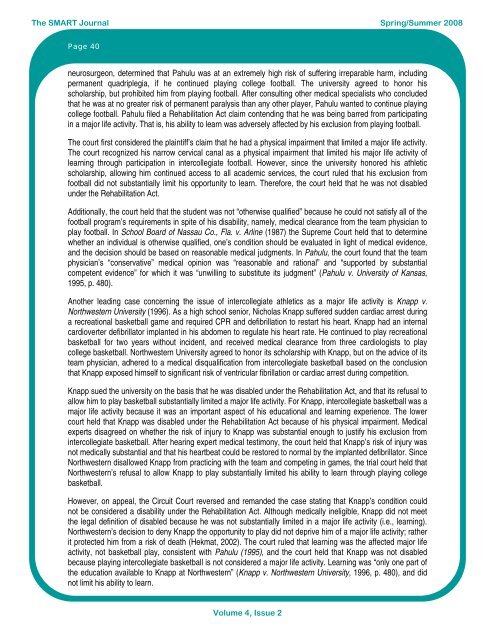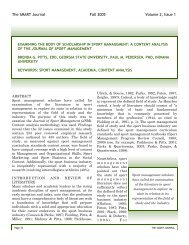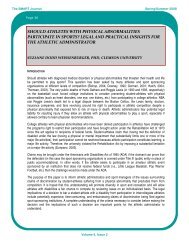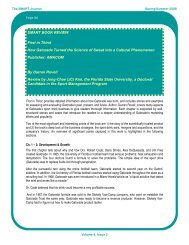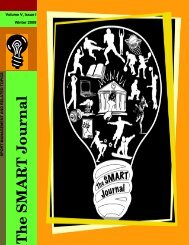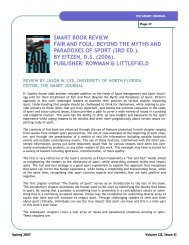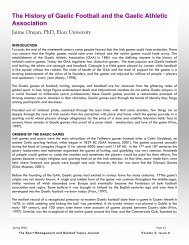Spring/Summer 2008 Volume 4, Issue 2 - The SMART Journal
Spring/Summer 2008 Volume 4, Issue 2 - The SMART Journal
Spring/Summer 2008 Volume 4, Issue 2 - The SMART Journal
Create successful ePaper yourself
Turn your PDF publications into a flip-book with our unique Google optimized e-Paper software.
<strong>The</strong> <strong>SMART</strong> <strong>Journal</strong> <strong>Spring</strong>/<strong>Summer</strong> <strong>2008</strong><br />
Page 40<br />
neurosurgeon, determined that Pahulu was at an extremely high risk of suffering irreparable harm, including<br />
permanent quadriplegia, if he continued playing college football. <strong>The</strong> university agreed to honor his<br />
scholarship, but prohibited him from playing football. After consulting other medical specialists who concluded<br />
that he was at no greater risk of permanent paralysis than any other player, Pahulu wanted to continue playing<br />
college football. Pahulu filed a Rehabilitation Act claim contending that he was being barred from participating<br />
in a major life activity. That is, his ability to learn was adversely affected by his exclusion from playing football.<br />
<strong>The</strong> court first considered the plaintiff’s claim that he had a physical impairment that limited a major life activity.<br />
<strong>The</strong> court recognized his narrow cervical canal as a physical impairment that limited his major life activity of<br />
learning through participation in intercollegiate football. However, since the university honored his athletic<br />
scholarship, allowing him continued access to all academic services, the court ruled that his exclusion from<br />
football did not substantially limit his opportunity to learn. <strong>The</strong>refore, the court held that he was not disabled<br />
under the Rehabilitation Act.<br />
Additionally, the court held that the student was not “otherwise qualified” because he could not satisfy all of the<br />
football program’s requirements in spite of his disability, namely, medical clearance from the team physician to<br />
play football. In School Board of Nassau Co., Fla. v. Arline (1987) the Supreme Court held that to determine<br />
whether an individual is otherwise qualified, one’s condition should be evaluated in light of medical evidence,<br />
and the decision should be based on reasonable medical judgments. In Pahulu, the court found that the team<br />
physician’s “conservative” medical opinion was “reasonable and rational” and “supported by substantial<br />
competent evidence” for which it was “unwilling to substitute its judgment” (Pahulu v. University of Kansas,<br />
1995, p. 480).<br />
Another leading case concerning the issue of intercollegiate athletics as a major life activity is Knapp v.<br />
Northwestern University (1996). As a high school senior, Nicholas Knapp suffered sudden cardiac arrest during<br />
a recreational basketball game and required CPR and defibrillation to restart his heart. Knapp had an internal<br />
cardioverter defibrillator implanted in his abdomen to regulate his heart rate. He continued to play recreational<br />
basketball for two years without incident, and received medical clearance from three cardiologists to play<br />
college basketball. Northwestern University agreed to honor its scholarship with Knapp, but on the advice of its<br />
team physician, adhered to a medical disqualification from intercollegiate basketball based on the conclusion<br />
that Knapp exposed himself to significant risk of ventricular fibrillation or cardiac arrest during competition.<br />
Knapp sued the university on the basis that he was disabled under the Rehabilitation Act, and that its refusal to<br />
allow him to play basketball substantially limited a major life activity. For Knapp, intercollegiate basketball was a<br />
major life activity because it was an important aspect of his educational and learning experience. <strong>The</strong> lower<br />
court held that Knapp was disabled under the Rehabilitation Act because of his physical impairment. Medical<br />
experts disagreed on whether the risk of injury to Knapp was substantial enough to justify his exclusion from<br />
intercollegiate basketball. After hearing expert medical testimony, the court held that Knapp’s risk of injury was<br />
not medically substantial and that his heartbeat could be restored to normal by the implanted defibrillator. Since<br />
Northwestern disallowed Knapp from practicing with the team and competing in games, the trial court held that<br />
Northwestern’s refusal to allow Knapp to play substantially limited his ability to learn through playing college<br />
basketball.<br />
However, on appeal, the Circuit Court reversed and remanded the case stating that Knapp’s condition could<br />
not be considered a disability under the Rehabilitation Act. Although medically ineligible, Knapp did not meet<br />
the legal definition of disabled because he was not substantially limited in a major life activity (i.e., learning).<br />
Northwestern’s decision to deny Knapp the opportunity to play did not deprive him of a major life activity; rather<br />
it protected him from a risk of death (Hekmat, 2002). <strong>The</strong> court ruled that learning was the affected major life<br />
activity, not basketball play, consistent with Pahulu (1995), and the court held that Knapp was not disabled<br />
because playing intercollegiate basketball is not considered a major life activity. Learning was “only one part of<br />
the education available to Knapp at Northwestern” (Knapp v. Northwestern University, 1996, p. 480), and did<br />
not limit his ability to learn.<br />
<strong>Volume</strong> 4, <strong>Issue</strong> 2


